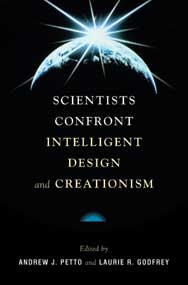Since the humiliating defeat of the creationist lobby in the Scopes Monkey Trial of 1925 in Tennessee, religious groups have grown increasingly sophisticated (more nuanced and organised and more sophistical) in their efforts to promote the idea that the universe and life in this remote corner of it were made by an intelligent agency, somewhat as a carpenter makes a table; except that the putative mega-agency did not have materials (the analogue of wood and nails) to hand beforehand, but made them too, ex nihilo.
 Thus literalist Six Day Creationism mutated (evolved? or would it be too tendentious to employ this term?) into new disguises, as “Creation Science” and – yet more sophisticatedly – Intelligent Design theory. Creation Science purports to show that the geological and fossil record is all explicable in terms of a single act of creation by a suitable agency, and a world-wide flood.
Thus literalist Six Day Creationism mutated (evolved? or would it be too tendentious to employ this term?) into new disguises, as “Creation Science” and – yet more sophisticatedly – Intelligent Design theory. Creation Science purports to show that the geological and fossil record is all explicable in terms of a single act of creation by a suitable agency, and a world-wide flood.
On this view vegetarian Tyrannosaurus Rex shared Eden with Adam and Eve, and so great was the weight of waters in the Flood that what look like aeons of geological strata were laid down in the short span of time between the rain and the dove’s return with a twig of leaves in its beak.
Intelligent Design (ID) theory is more insidiously disguised, because it does not invoke either of the two creation myths in Genesis directly, but tries to argue on putative scientific grounds that there is irreducible complexity in nature that can only be explained as the outcome of intelligent design. Its proponents thereby construct a Trojan Horse for Creationism by arguing that their theory, as a scientific theory, should have equal time in schools with Darwinian biology.
The naïve absurdities of Creationism in any disguise, and the sophistries and dishonesties of ID, have received repeated setbacks in American courtrooms in recent years, as school boards in more backward states have tried to insinuate the religious agenda into the teaching of school science, only to be contested and consistently defeated by First Amendment defenders.
The money, organisation, propaganda effort and persistence of the religious lobby are remarkable; entire “institutes” to promote its agenda exist, a notable example being the richly funded “Discovery Institute” in Seattle, which laughably describes itself in its promotional literature as “a nonpartisan public policy think tank conducting research on technology, science and culture, economics and foreign affairs”. Ten seconds reading its home page blurbs gives the lie to any implication of neutrality and dispassion.
Twenty years ago Laurie S Godfrey edited a collection of essays entitled Science Confronts Creationism. Here she returns, in company with Andrew J Petto, to take up the cudgels again. The title of their new collection registers the evolution in religious efforts just described; the earlier collection addressed Creationism, this one addresses both Creationism and ID.
The cancer, in short, has continued to spread. It scarcely needs saying that the essays are individually and jointly conclusive in their aims; what makes one shake one’s head is the time, energy and effort these genuine scientists have been obliged to direct towards combating the irresponsible absurdities of Creationism and ID, distracting them from their real work because they have to defend their disciplines, and indeed American education, from the corrosive effects of disguised and confabulated versions of superstition.
It has to be confessed, though, that the essays make for entertaining reading. A prime example is the comprehensive and swingeing demolition by Victor J Stenger of ID theory’s darling, William Dembski, whose quite remarkably dishonest (or ignorant) manipulations of statistics and information theory, to “prove” that biological systems are too complex to have evolved naturally, have been ID’s mainstay. This indeed is the key to the ID challenge, and essay after essay here powerfully shows how this is nothing but an argument from ignorance, usually the ID proponent’s own.
The really surprising thing, though, is this. What is the value of saying, with respect to anything we do not, or do not yet, understand, that it was made by an invisible one-eyed toad (insert an arbitrary agent of your choice)? The child’s question presses: viz. if the universe and life in this corner of it had to be designed by (say) Mother Goose, who is she that she could do such a thing? Is she complex, and therefore did she need a designer in her turn? If so, that designer must have been pretty complex too, if not indeed more so, and would need a fancier designer in its own turn . . . and so on ad infinitum. Explanatory regresses with no first term explain nothing.
In short, the explanatory value of an arbitrary, plucked-out-of-thin-air idea of a designer to “explain” the universe and the complexity of life in it is null, vacuous, empty. What possible sense do the votaries of such a pointless view think they are making? Well, of course, their entire effort is devoted to finding premises for an antecedently accepted conclusion; they know in advance the answer, and are trying to fabricate the right questions to get to it; they know what they wish to prove, and are scrounging around for evidence, or for ways of twisting evidence that points to different conclusions, to do so. They subscribe for non-rational reasons to one of many creation myths from the infancy of mankind, and are scrabbling for justifications in support of it. This is as far from science, rationality and intellectual honesty as you can get.
The ID project addresses itself mainly to biology in opposition to evolutionary theory. Creation science addresses itself mainly to the physics of cosmogony and cosmology, the origins and nature of the universe. They overlap when they invoke the fact that life could not exist on this planet unless the constants of nature were fine-tuned exactly as they are.
To a mind naively seeking straws for a house of straw, the fact that the universe is fine-tuned for life is like the way Dr Pangloss, in Voltaire’s Candide, accounts for the nose: that it exists to support our spectacles. Dr Pangloss inferred the necessity of the nose from the existence of spectacles; he did not bother to consider other ways of remedying defects of vision, or note the many other facial arrangements which do not support spectacles as ours do, but nevertheless exist; and so on. Just so do the invokers of the anthropic principle fail to think there might be other forms of life possible in universes tuned to different constants, or many other universes anyway, or different phases in this one determined by different values of changing constants.
Again: what a waste of effort is here provoked by the necessity to quash absurdity. Take just one example in illustration. Creationists contest isotopic dating techniques which show that the earth is billions of years old by suggesting that “since the Creation one or more episodes occurred when nuclear decay rates were billions of times greater than today’s rates. Possibly there were three episodes: one in the early part of the Creation week, another between the Fall and the Flood, and the third during the year of the Genesis Flood” (this from a publication by a creationist group calling itself RATE – “Radioisotopes and the Age of the Earth”). Brent Dalrymple calmly points out that for this suggestion to be true would require changes in fundamental constants including Planck’s constant and the speed of light, which in turn changes the nature of light and many other physical and chemical properties, and thus the universe no longer works – or a very different one would result. Such is the quality of thought, which in understatement Dalrymple describes as “incredibly naïve”.
Alas, while the folk of faith continue trying to sell their snake-oil views, and no doubt succeed with the gullible and those anxious to bolster their convictions, the necessity will remain to contest them. The ancient tales are quick and easy to sell, the depth and complexity of real science take effort to understand; the snake-oil purveyors have this asymmetry on their side.
Thus it is that the fine contributors to this excellent collection have to devote time to arguing that there are no fairies at the bottom of the garden. It is no wonder that the attitude of non-religious people is hardening against the continued tiresome endeavours of the fairy-worshippers, making the debate a bad-tempered one. It is to the credit of the contributors to this volume that they all remain cool, measured and conclusive throughout. ■
Scientists Confront Intelligent Design and Creationism is published by WW Norton

